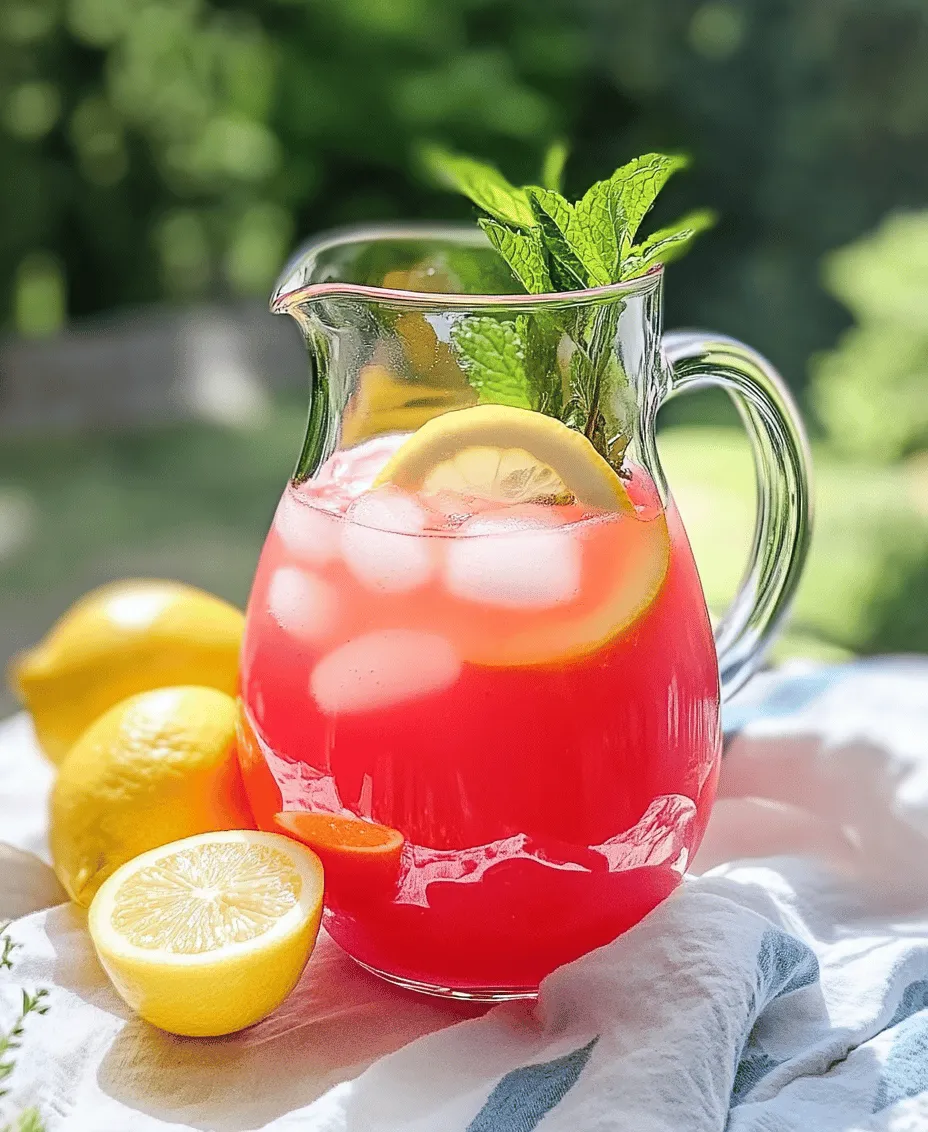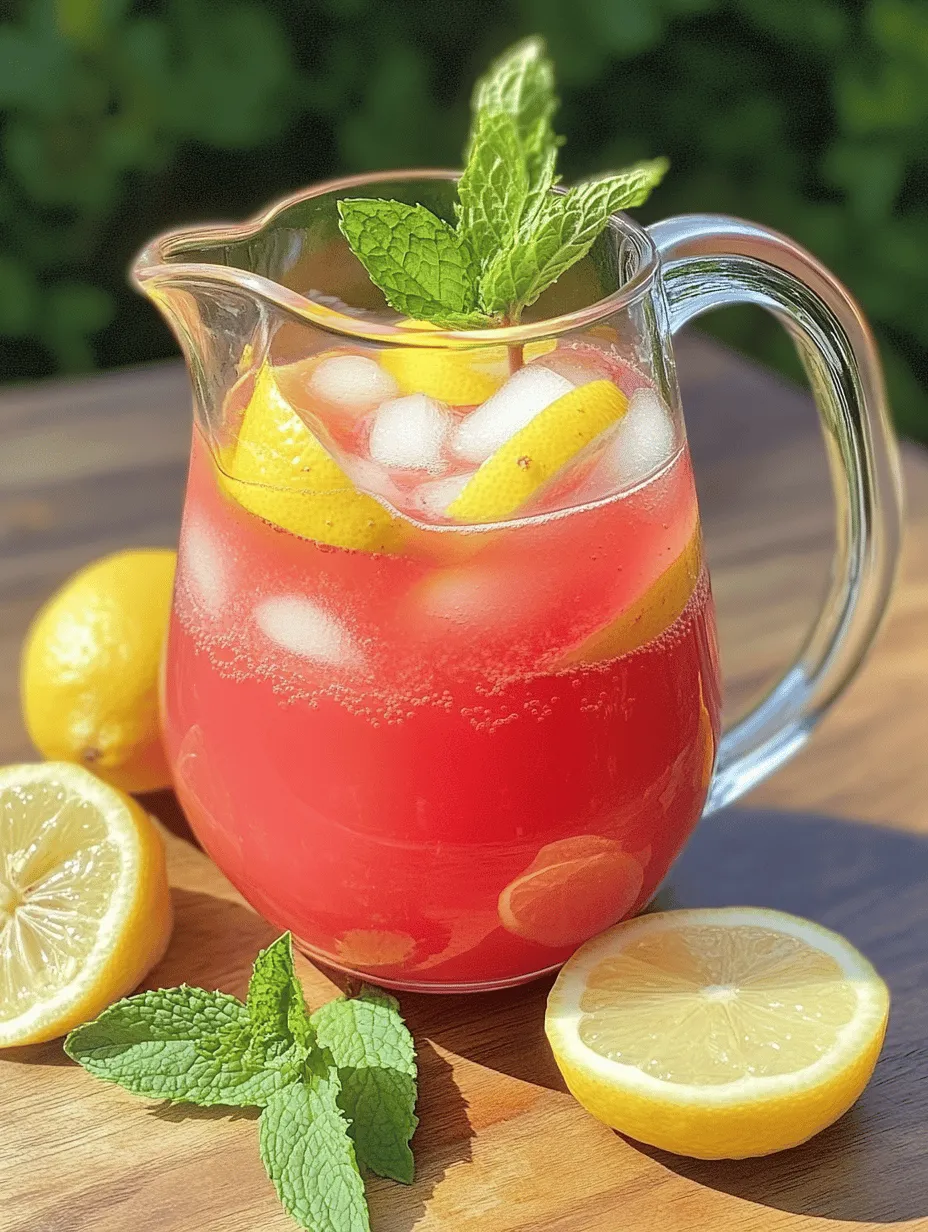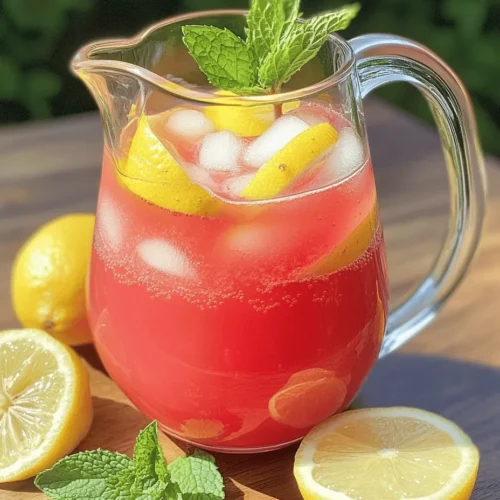Introduction
As the temperatures rise and the sun shines brightly, the allure of refreshing beverages becomes undeniable. Whether lounging by the pool, hosting a garden party, or simply seeking relief from the summer heat, nothing quenches thirst quite like a chilled drink. Among the plethora of summer beverages, lemonade stands out as a timeless classic, embraced for its bright, tart flavor and thirst-quenching properties. However, this article introduces a delightful twist on the traditional favorite: Refreshing Rhubarb Lemonade.
Rhubarb, often associated with pies and desserts, is an underappreciated ingredient that brings a unique and vibrant flavor profile to beverages. Its tartness, reminiscent of a slightly sour berry, pairs beautifully with the sweetness of lemonade, creating a harmonious balance that is both refreshing and invigorating. By incorporating rhubarb into your lemonade, you can elevate this quintessential summer drink into something truly special.
Moreover, the benefits of homemade beverages cannot be overstated. Crafting your own drinks allows you to control the ingredients, ensuring a fresher and healthier option compared to many store-bought alternatives that are often laden with preservatives and artificial flavors. In this article, you can expect a detailed guide on how to prepare rhubarb lemonade, along with insights into the preparation process that will help you create the perfect summer refreshment.
Understanding Rhubarb
Rhubarb, scientifically classified as *Rheum rhabarbarum*, is a perennial plant that belongs to the family Polygonaceae. While it is often treated as a fruit in culinary applications, rhubarb is technically a vegetable, characterized by its long, thick stalks that can range in color from vibrant pink to deep red, with greenish hues as well. The leaves, however, are toxic and should not be consumed, making it crucial to focus on the stalks for culinary uses.
Culinary-wise, rhubarb is most commonly found in desserts such as pies, tarts, and crumbles, where its tartness can be balanced with sugar. However, its unique flavor also lends itself well to beverages, making it an ideal candidate for lemonade. In addition to its culinary versatility, rhubarb boasts several nutritional benefits. It is low in calories yet rich in vitamins and antioxidants, including vitamin K, vitamin C, and various phytonutrients. These compounds contribute to overall health, supporting bone health, immune function, and reducing inflammation.
Despite its many benefits and culinary applications, rhubarb often faces misconceptions; some may dismiss it as solely a dessert ingredient. However, its tart flavor can be a delightful addition to a variety of drinks, making it a hidden gem in the world of mixology. Whether you’re sipping on a refreshing rhubarb lemonade or experimenting with other rhubarb-infused beverages, this unique ingredient has much to offer.
The Appeal of Lemonade
Lemonade has a long-standing historical significance as a refreshing summer drink. Its origins can be traced back to ancient civilizations, where lemon juice was mixed with water and sweeteners. Fast forward to modern times, and lemonade has become synonymous with summer, often served at picnics, barbecues, and family gatherings. It embodies the essence of sunny days and warm evenings, making it a staple in many households.
Around the globe, variations of lemonade abound, showcasing the creativity and diversity of cultures. From the sweet, syrupy Turkish lemonade to the spicy ginger lemonade of India, each region has its own take on this classic drink. The recent trend of infusing lemonade with creative flavors—such as lavender, cucumber, or, in this case, rhubarb—has opened up a world of possibilities for beverage enthusiasts. Rhubarb lemonade stands out as a perfect twist on the classic favorite, combining the refreshing qualities of traditional lemonade with the unique tartness of rhubarb.
This delightful concoction not only quenches thirst but also offers a visually appealing drink, with its beautiful pink hue reminiscent of summer sunsets. As you explore the world of rhubarb lemonade, you’ll discover how this innovative drink can elevate your summer gatherings and provide a refreshing respite on hot days.
Ingredients Breakdown
To create the perfect rhubarb lemonade, you’ll need a few key ingredients that come together to form a deliciously vibrant drink. Here’s a breakdown of the primary components required for this recipe:
– Fresh Rhubarb Stalks: The star of the show, fresh rhubarb stalks provide the tartness and beautiful color of the lemonade. When selecting rhubarb, look for firm, crisp stalks with a vibrant hue. Avoid any stalks that appear wilted or have soft spots.
– Fresh Lemons: Lemon juice is essential for the classic lemonade flavor. Freshly squeezed lemon juice is preferred, as it offers a bright, zesty flavor that bottled lemon juice cannot replicate. You’ll need about four to six lemons to yield the necessary juice for this recipe.
– Water: Water is used to create the lemonade base and to boil the rhubarb when making the syrup. It’s best to use filtered water for the cleanest taste.
– Sugar: To balance the tartness of the rhubarb and lemons, granulated sugar is added. The amount can be adjusted based on your taste preference—feel free to experiment with alternative sweeteners if desired.
– Ice: Ice is essential for serving your lemonade chilled, making it incredibly refreshing on a hot summer day.
– Garnishes (Optional): Additional garnishes, such as lemon slices, fresh mint leaves, or even a sprig of rhubarb, can enhance the presentation and add a hint of extra flavor. These small touches can elevate your drink, making it aesthetically pleasing and inviting.
Using fresh ingredients is crucial for achieving optimal flavor in your rhubarb lemonade. The vibrant colors and natural sweetness of fresh rhubarb and lemons will significantly enhance your drink, providing a more enjoyable and authentic experience.
Step-by-Step Preparation of Rhubarb Lemonade
Now that we’ve covered the ingredients, it’s time to dive into the preparation of this delightful rhubarb lemonade. The process begins by creating a rhubarb syrup, which serves as the base for your lemonade. Follow these detailed instructions for making the syrup:
1. Prepare the Rhubarb: Start by washing the rhubarb stalks thoroughly to remove any dirt or debris. Trim off the ends and cut them into small pieces, roughly one-inch long. The smaller the pieces, the quicker they will release their flavor during the cooking process.
2. Cook the Rhubarb: In a medium saucepan, combine the chopped rhubarb, water, and sugar. Use a ratio of 1 part rhubarb to 2 parts water for a balanced syrup. For instance, if you use 2 cups of chopped rhubarb, add 4 cups of water and 1 cup of sugar.
3. Heat the Mixture: Place the saucepan over medium heat. It’s important to control the heat during this step. Bring the mixture to a gentle boil, stirring occasionally to help dissolve the sugar. Once it reaches a boil, reduce the heat to low and let it simmer for about 15-20 minutes. This allows the rhubarb to soften and release its natural flavors. You’ll notice the mixture turning a beautiful pink color as it cooks.
4. Strain the Syrup: After simmering, remove the saucepan from heat and let it cool slightly. Use a fine-mesh strainer or cheesecloth to strain the syrup into a clean container, discarding the solids. This will leave you with a smooth, vibrant rhubarb syrup that will serve as the foundation of your lemonade.
5. Combine with Lemon Juice: In a pitcher, combine the strained rhubarb syrup with freshly squeezed lemon juice. The ratio can vary, but a good starting point is to mix 1 cup of rhubarb syrup with 1 cup of lemon juice. Stir well to combine, adjusting the sweetness and tartness to your liking.
With these initial steps, you have laid the groundwork for a refreshing summer drink that will impress your family and friends. Stay tuned for the next section, where we will explore how to finish off your rhubarb lemonade and serve it in style.




